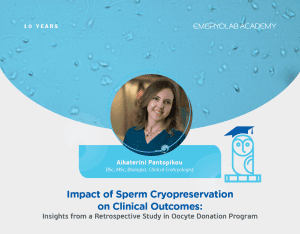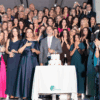Aikaterini Pantopikou, BSc, MSc, Biologist, Clinical Embryologist
In the field of Assisted Reproductive Technology (ART), oocyte donation programs offer a ray of hope for individuals and couples struggling with infertility. A crucial aspect of these programs revolves around the quality of sperm used for fertilization. The choice between utilizing fresh or frozen sperm is a matter of ongoing debate, with each option presenting a unique set of benefits and factors to consider.
A primary concern when selecting sperm for oocyte donation pertains to the success rates of fertilization and achieving a pregnancy. Fresh sperm has the advantage of being immediately available for use allowing for immediate fertilization of the collected oocytes. This can potentially lead to higher fertilization rates and increased chances of conception. On the other hand, frozen sperm can be stored for extended periods offering the flexibility of timing the oocyte donation to align with the donor’s oocyte retrieval. However, it’s worth noting that while cryopreservation techniques have seen substantial improvements over the years, frozen sperm might experience some diminution in viability and motility during the freezing and thawing process, which could potentially affect success rates when compared to fresh sperm.
Until now, the available data has presented conflicting conclusions regarding the impact of fresh versus frozen sperm on pregnancy rates and the rate of live births (LBR). Some studies indicate a reduction in LBR when frozen sperm is used in donation programs, while other research shows no significant difference in LBR between fresh and frozen sperm.
A retrospective cohort study was conducted at Embryolab, enrolling a total of 135 cases, where fresh sperm was used in 28 cases, and frozen sperm was used in 107 cases. The mean age of men was 44.4 years, and all oocyte donors were under 35 years old. The primary outcome measure was the LBR, while factors like fertilization rate, blastulation rate, and positive β-HCG were also meticulously analyzed. Importantly, individuals with uterine factor, male factor infertility, or surgically obtained sperm were excluded from the study.
The results of this study, presented at the 39th Annual ESHRE conference, demonstrated no significant difference in the LBR between fresh sperm (54%) and frozen sperm (50%, p=0.086). While positive β-HCG levels were slightly higher in fresh sperm samples, this difference was not statistically significant (86% in fresh vs 78% in frozen sperm, p=0.857). Likewise, both blastulation rate (68.93% in fresh vs 67.97% in frozen sperm, p=0.873) and fertilization rate (85.36% in fresh vs 83.27% in frozen sperm, p=0.565) did not exhibit any substantial difference between fresh and frozen sperm samples.
The decision-making process between fresh and frozen sperm in oocyte donation programs requires a thorough evaluation of various factors, including success rates, convenience, cost, and overall effectiveness. Based on our data, the use of frozen sperm emerges as a viable choice in donation programs, as it does not entail any detrimental effects on the LBR. However, specific subgroups, particularly those with low sperm parameters, might derive additional benefits from the utilization of fresh sperm.







